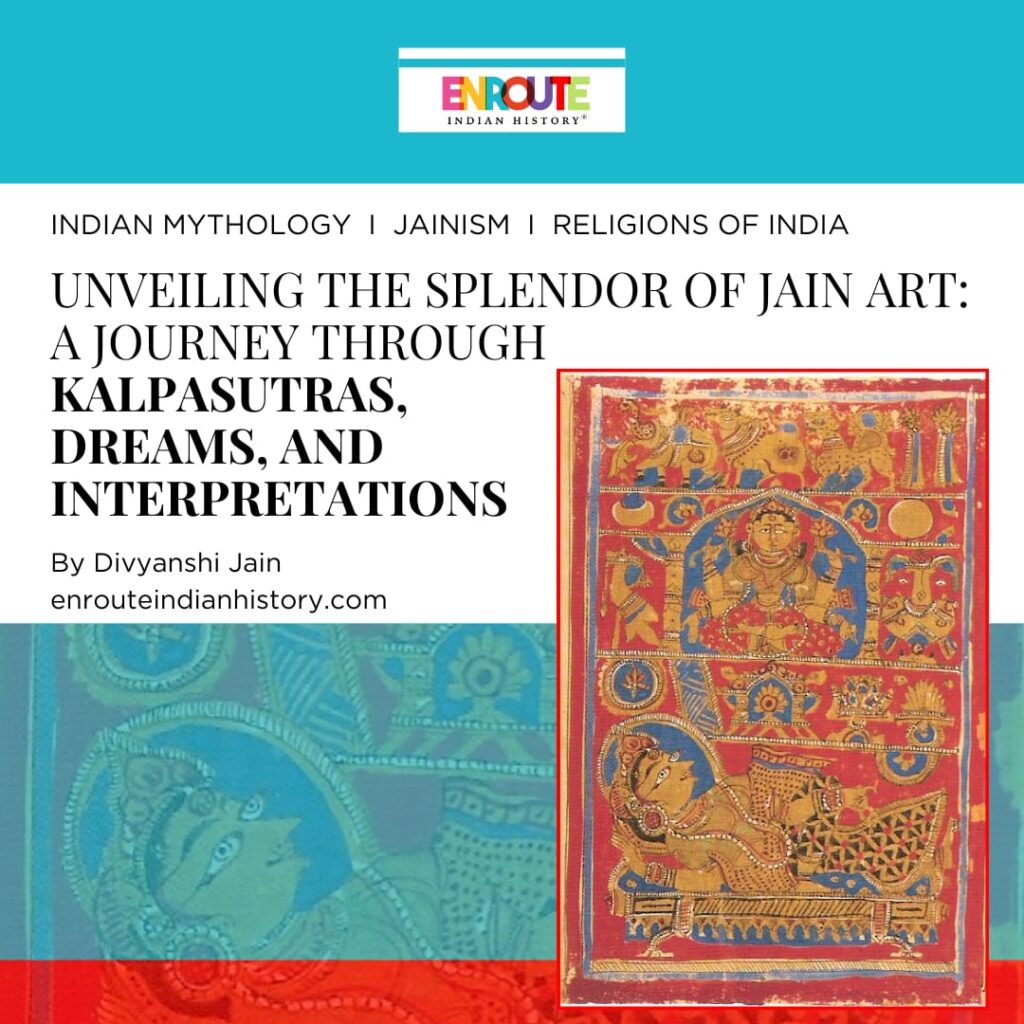Unveiling the Splendor of Jain Art: A Journey through Kalpasutras, Dreams, and Interpretations
- enrouteI
- December 14, 2023

In the rich landscape of Indian mythology, Jainism emerges as an ancient, profound belief system, intricately woven with artistry that adorns manuscripts and preserves sacred narratives. Jain art, a vibrant reflection of this cultural ethos, finds its zenith in the exquisite depictions within the Kalpasutras, blending spirituality, symbolism, and the enigmatic realm of dreams.

Auspicious Dreams as an ornamentation on the cover of a 19th-century manuscript, Victoria and Albert Museum
Originating around the 11th century and flourishing predominantly from the 13th century in regions like Gujarat, Rajasthan, and occasionally Jaunpur, Uttar Pradesh, Jain manuscripts evolved into opulent treasures by the 15th century, embellished with the grandeur of gold. Among these cherished manuscripts, the Kalpasutra holds a preeminent position, chronicling the lives of revered Tirthankaras such as Parshvanatha and Mahavira.
The Kalpasutra was a compendium of rituals and narratives, particularly chronicling the lives of revered Tirthankaras, notably Parshvanatha and Mahavira. Mahavira, the 24th Tirthankara, took birth in Bihar, India, in the early 6th century BC. Attributed to Bhadrabahu and believed to have been composed around 150 years post Mahavira’s salvation, the Kalpasutra presents detailed life histories, evolving to feature exquisite miniature paintings in the Western Indian school style.
Comprising three sections, the Kalpasutra first delves into the lives of the 24 Tirthankaras, revered spiritual luminaries guiding souls toward Nirvana. The second section, a poignant narration, encapsulates the life saga of Lord Mahavira. Finally, the third section delineates the rules governing monks during the rainy season, a period when they temporarily forego their nomadic existence, immersing themselves among ordinary people, commemorating the recital of Kalpasutra and celebrating the Paryushan festival. This revered scripture is exclusively accessible to Jain monks, embodying profound veneration within Jainism.
One compelling narrative from the Kalpasutra chronicles the transfer of Mahavira’s embryo from Brahmani Devananada’s womb to that of Trishala, his mother. This mystical exchange was heralded by Trishala witnessing 14 auspicious symbols in her dreams—a portrayal that echoes the profound significance of dreams within Jain beliefs.

Queen Trishala, Mahavira’s mother has 14 auspicious dreams. Folio 4 from Kalpasutra

Queen Trishala and the fourteen auspicious dreams. Miniature painting of an undated manuscript (c. late 14th century CE) from Sri Jaisalmera Gnana Bhandar, Jaisalmer
The two panels shown below are taken from Kalpasutra. They are in progression and need to be understood as a story unfolding in texts and miniature paintings. Here, the first panel shows the mother of Mahavira- Mata Trishala and the 14 symbols of her dreams. Next to this comes the Panel showing King Siddhartha, Mahavira’s father who has summoned dream interpreters and scholars to understand the significance of the unusual dreams.

Queen Trishala’s Dreams, Kalpa Sutra,15th century, Jaunpur, Uttar Pradesh, Metmuseum, USA.

King Siddhartha summons dream interpreters, Kalpasutra LACMA, USA.
Indeed, the Kalpasutra transcends mere religious literature, intersecting with ancient dream interpretation theories. Symbols like the elephant, lion, sun, moon, and celestial elements hold deeper, symbolic connotations. An elephant foretells a thunderous voice for the child, while a lion symbolizes kingship and protection of monks. Nature’s elements like the sun and moon signify dispelling darkness and eradicating societal shadows, respectively. Religious motifs such as flags, vimanas, gemstones, and pitchers bear interpretations rooted in their inherent symbolism, weaving a tapestry of divinity and auspiciousness.
A pioneer historian of Indian art, Coomaraswamy wrote several essays on Jain art. One of his insightful interpretations unveils the profound metaphysical essence embedded in the depiction of ‘Fortunate Sunrise'(Sri Suryodaya)—the morning after Trishala’s transformative dreams and conception. This evocative portrayal transcends the mere visual representation of a landscape, symbolizing the birth of the Great Hero and the resplendence that permeates the universe with a singular light (Jyotir Jyotisam).
While the dreams are depicted in paintings found in the manuscripts, there is also a practice that preserves them. During particular festivals, certain rituals are undertaken where the dreams are portrayed as a part of “natak”. Take for example the construction of a Jain temple. When the constructed temple needs to be institutionalized- an event called “Panchakalyanak” ( literally- five events) is held. One of the Kalyanak is the Garbha-kalyanak where the birth of a Tirthankara is shown through an act of drama showing the dreams of Tirthankara’s mother and their interpretation. Thus, the narrative found in manuscripts becomes a living one.
Dreams are a recurring theme in other Jain tales as well. The tale of Prince Sreyamsa stands as an illustrious narrative. He holds the distinction of being the first individual capable of presenting fitting alms to the first Jina, Rishabhnath. This momentous event transpired after Jina’s year-long fast, a significant spiritual feat. The anticipated visit of the revered Jina to Sreyamsa was heralded by a dream.
Jain art, epitomized by the Kalpasutra and its interplay with dreams and their interpretations, stands as a testament to the intricate nuances of Indian mythology entrenched within Jainism. This artistic legacy not only mirrors the richness of Jain heritage but also invites deeper exploration into its profound symbolism and spiritual depth, enriching the vast expanse of Indian mythology.
Jain Art
REFERENCES
1. Ananda K. Coomaraswamy’s Essays of Jaina Art | IGNCA. ignca.gov.in/ananda-k-coomaraswamys-essays-of-jaina-art.
- Authors: John Guy. “Jain Manuscript Painting.” The Met’s Heilbrunn Timeline of Art History, 1 Jan. 1AD, www.metmuseum.org/toah/hd/jaim/hd_jaim.htm.



















